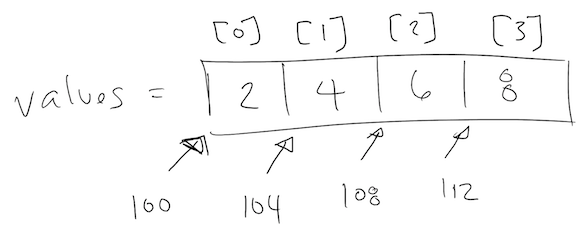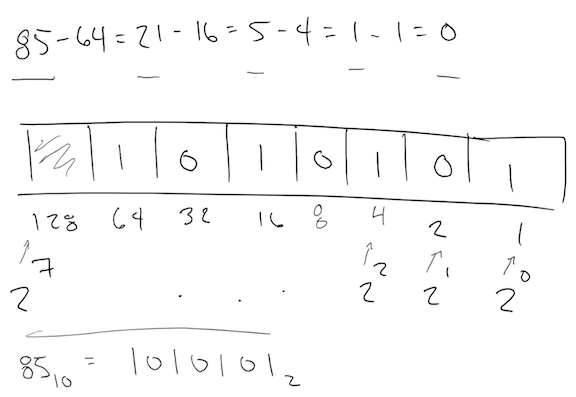| Previous Lecture | Lecture 7 | Next Lecture |
Lecture 7, Tue 07/24
Arrays and Number Representations
Arrays
- An array is used to organize a collection of values of the same type.
- So far, we have been writing programs where values aren’t stored in a collection, but single variables.
- Another way to think of arrays under-the-hood is a sequence of cells that are stored contiguously in memory.
Computer Memory Illustration

- Memory addresses are usually byte-addressable (i.e. a distinct memory location refers to eight bits of information).
- During compilation, the compiler knows how much memory to reserve for variables (including arrays) that are declared.
- This is why we must declare all variables with a type.
Declaring Arrays
int a[10];
- Arrays need a type defined (int), a variable name (a) and a size (10).
- We can check the size of a type using the
sizeoffunction, which returns the size of a value in bytes.
cout << sizeof(5) << endl; // 4 (int)
cout << sizeof(11.1) << endl; // 8 (double)
char b = 'b';
cout << sizeof(b) << endl; // 1 (char)
- The array
awill have a size of 10 * sizeof(int) in this case.
int a[10];
cout << sizeof(a) << endl; // 40
Bracket Syntax
- Accessing an individual cell of an array uses a traditional
[ ]syntax, which is indexed starting at 0.- The first element is a[0]. The last element is a[9].
- Initially, each cell is undefined (may contain junk data).
- Remember, it’s important to explicitly initialize values in C++.
int a[100];
for (int i = 0; i < 100; i++) {
cout << a[i] << endl;
}
- Notice how some elements in the array may contain random values since we didn’t initialize values in the array.
Example of reading / writing values from / to the array
a[0] = 1;
a[1] = -5;
a[1] = a[0]; // fetching and storing array values
- For all practical purposes, an element in an array can be treated as a value whose type is what the array was defined as.
- An example using
cin:
int a[10];
cout << "Enter a number: ";
cin >> a[0];
cout << "a[0] = " << a[0] << endl;
- An example using functions
void passArrayValueExample(int x) {
cout << “Parameter value: “ << x << endl;
}
int main() {
int x[1];
x[0] = 3;
passArrayValueExample(a[0]); // prints 3
}
Example of iterating through the entire array
int a[10];
for (int i = 0; i < 10; i++) {
a[i] = i; // initializes elements using i
}
int x = a[5] + 2;
cout << x << endl; // 7
- Unlike some languages, C++ arrays cannot be indexed with negative numbers.
- Arrays do not know what their size is, so programmers will need to keep track of that.
Shorthanded way to declare and initialize arrays
char grades[] = {‘A’, ‘B’, ‘C’, 'D', 'F'};
- This declares a char array named grades and initializes 5 elements with the values in between the
{ }.
Memory addresses of array elements
- Assuming the array
int values[] = {2,4,6,8};is located at the memory address 100, what memory address wouldvalues[3]be located?

Number Representation
- Humans are used to dealing with numbers in Decimal (base 10) notation.
- Computers MUST deal with numbers in Binary (base 2) notation (0’s and 1’s)
- Physical property of hardware stores state in positive / neutral charges.
- Each binary value is called a bit.
- Eight bits make up a byte.
Converting values in different bases to base 10
- We can take the digits from the source base, and sum up the digit times the base’s power (starting from 0) in ascending order from right-to-left.
- Example converting 1105 = ____10
1 * 52 + 1 * 51 + 0 * 50
= 25 + 5 + 0
= 30
- Example converting 11012 = ____10
1 * 23 + 1 * 22 + 0 * 21 + 1 * 20
= 1 * 8 + 1 * 4 + 0 * 2 + 1 * 1
= 13
-
We can compute the number of unique values n binary bits have with 2n.
-
The number of unique values 4 bits can represent is:
24 = 16
- Computer applications can use binary combinations to represent values other than numbers.
- American Standard Code for Information Interchange (ASCII) uses 1 byte to represent characters.
- UTF-8 uses 1 - 4 bytes to contain characters for many languages.
Converting base 10 to binary (base 2)
- We can use the “best-fit” approach using powers of 2.
- See which largest power of two is less than that number.
- Write a ‘1’ in the appropriate place, and a ‘0’ for any values that are larger.
- Replace the value by subtracting it by the largest power of two less than the current value.
- Repeat until the value is 0.

Hexadecimal Numbers
- Hexadecimal values are represented with a base 16, where each digit is represented with either [0-9] or [A-F].
- Memory addresses are usually represented in hexadecimal notation.
- A common hexadecimal notation has
0xpreceeded by the hexadecimal value.- We’ll see this notation when printing memory addresses in our C++ programs.
Hex Value Binary Value
0 0000
1 0001
2 0010
3 0011
4 0100
5 0101
6 0110
7 0111
8 1000
9 1001
A 1010
B 1011
C 1100
D 1101
E 1110
F 1111
- Conversion from hexadecimal to binary simply takes the hexadecimal digit and substitutes the binary representation.
- Example: Convert 0x13C to binary.
116 = 0001
316 = 0011
C16 = 1100
0x13C = 0001001111002
- Converting from binary to hexadecimal substitutes every 4 binary bits with the hexadecimal value.
0001,0011,1100
= 13C16